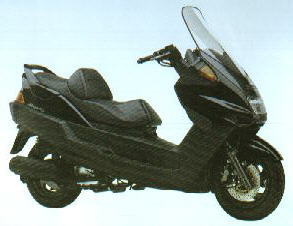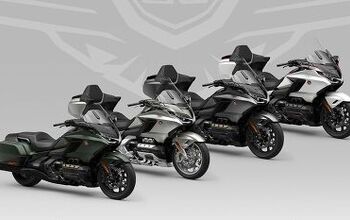Yamaha Majesty - Motorcycle.com
It's a new 250 from Japan with great weather protection, marvelous brakes and tires, and a steering system so high tech as to leave most motorcycles back in the Sixties. Sound like the most radical new design in months? It is.
But it's a scooter.
This scooter represents the second generation of high-tech scooter production. First generation scooters included the Honda CN250 Space, and the Piaggio Hexagon. A common, critical problem with these two scooters was the front suspension system.They've redesigned the entire bodywork, and you can see the results in the picture.
Neither has a classic hydraulic fork, but a double (CN250) and a single (Hexagon) swingarm system. These systems were able to provide quite good comfort during riding. But the trade off was an unsteady feeling, especially when the pavement was not perfect (and when is it ever?). So Yamaha decided to give their new scooter a motorcycle feel by installing a traditio
Another problem with scooters that Yamaha's engineers attempted to solve was wind blast on the rider. They've redesigned the entire bodywork, and you can see the results in the picture. It looks attractive enough, and reminds one of the front side of touring bikes like the BMW R1100 RT, and offers good protection to wind and rain. The similarity to a BMW is not limited to apperance. Considering the stated maximum speed (more than 126 Km/h), you'll be able to do some short touring, also. A trip of around 400 Km in one day would not be out of the question. There are several other cool features included with this scooter too, such as the seat, which opens toward the front and is held open by a hydraulic cylinder.
Yamaha is moving scooters forward to a new generation. As in the computer world, where as soon as a new machine is presented to public it's immediately replaced by the next model, we want to try and define the requirements for the third generation scooter:
Increasing wheel diameter to more than 15 inches (better 16 inch) Increasing the frame's torsional strength Increasing the diameter of the front fork Increasing the power and displacement of the engine (and of course the torque too) Increased power may cause some problems to the transmission system, so it might be necessary to devise a new system like the electronic/hydraulic sequential gear change system used in F1 racing and in some Porsche production models. Adding a rear disc brake Refining the wind/rain protection and the CX. With all of the above items incorporated into the next generation scooter, you would have a machine with good ride feeling, a satisfying cruise speed (around 140 Km/h), and good speed performance (max speed greater than 160 Km/h, quick acceleration, etc.). We hope another manufacturer would soon enter the challenge, which would stimulate competition, and help shorten the arrival time of the ultimate Third Generation Scooter.
Yamaha Majesty YP 250, Technical Data
| Engine | 4-stroke single, SOHC, liquid- cooled |
| CC | 249 |
| Bore/Stroke | 75.5 x 56mm |
| Power (DIN) | 20 CV at 6500 rpm |
| Torque (DIN) | 2.35 kg-m at 5500 rpm |
| Starter | Electrical |
| Fuel Tank | 1.1 Litres |
| Transmission | Automatic |
| Dimensions | 2110/750/1330mm (Length/Width/Height) |
| Wheelbase | 1500mm |
| Ground Clearance | 147mm |
| Weight | 147 kg (dry) |
| Suspension | Front: telescopic fork, Rear: swing arm with double shock absorber |
| Brakes | Front: disc - Rear: drum |
| Tires | Front: 110/90-12 64j, Rear: 130/70-12 62l |
More by Giulio Meccoci, Italian Desk.






























Comments
Join the conversation